A bit of Lockheed history revisited... Lockheed XP-73 Swordstar
Lockheed XP-73 Swordstar
After the XP-58
Chain Lightning was turned down by the USAF, Lockheed took the half-assembled second prototype and reworked all the elements to turn it into a single fuselage design for a fast piston interceptor, the
Model 39 Swordstar (a mix of "Swordfish", as in the XP-38E test-bed and the usual "star" suffix used by Lockheed). Though unsollicited, the proposal was judged interesting enough for the USAAF to borrow the aircraft from Lockheed and give it the XP-73 designation (serial 43-45315).
However, the
Swordstar was sadly lost after only three hours of test flying in mid-air collision with a Culver PQ-8 Dart target drone gone wild, killing test pilot Shane Bolt. The embarrassment was such that the Air Force agreed on a refund of the prototype and all of Lockheed's expenses on condition that the XP-73 be erased from the records, which was done on both sides. It would have remained a lost chapter of aviation history were it not for a set of documents hidden away by one of the project's engineers that resurfaced recently after his passing. Only this one very rare photograph of it has survived to this day.
The
Swordstar was a sort of missing link in Lockheed design history, being the last distant grandson of the P-38
Lightning family and also the company's last piston design before the F-80 Shooting Star, which was to incorporate its tail design with very little change.
 Lockheed YF-136/R9V-1 Super Constitution (Model 1089)
Lockheed YF-136/R9V-1 Super Constitution (Model 1089) 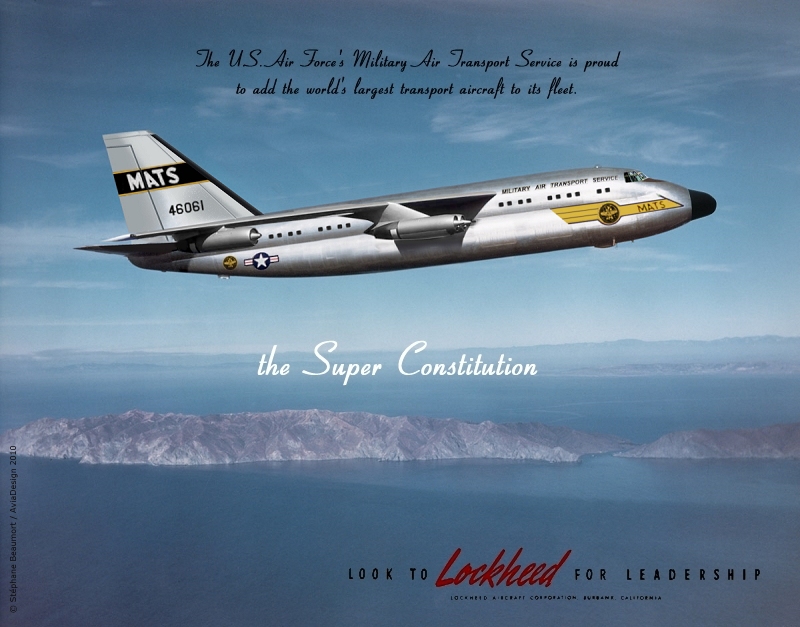
When the Lockheed Model 89
Constitution was retired in 1953, the U.S. Air Force expressed some interest and decided to purchase the two prototypes. The Military Air Transport Service (or MATS in short) needed large capacity transports that could carry both troops and materiel in large quantities. However, the two R7V-1s were not adapted to the demands of modern transport, and uphauling them proved more complicated than building two new aircraft.
Lockheed was asked, therefore to produce two off-the-shelf fuselages that could receive brand new swept wings with underwing jets on pods and a brand new tail. The Air Force requested that the wing's shape and engine configuration follow closely those of the Boeing B-47
Stratojet, which had recently entered service. In effect, the wings of the resulting
YF-136 Super Constitution (or Model 1089) appeared like scaled-up B-47 wings with beefed up General Electric J47 jet engines. The bottom deck became all cargo, while the top deck windows were fashioned after those of the Super Constellation. A nose radome was installed and a newer, modern cockpit introduced. The latter would soon serve as a basis for that of the Hercules.
The Navy briefly considered ordering two more examples as the
R9V-1, but this plan fell short when they realized they did not possess enough facilities and landing fields adapted to a transport aircraft of that size. Attempts by Lockheed to market the type on the civilian market also failed. The two
Super Constitutions were the pride and joy of MATS but were used only from November 1954 until June 1963, a short lifespan which can be explained by the fatigue of the fuselages, conceived just after the war for straight wings and props, and therefore not optimized for jet engines or swept wings.
 Lockheed YU-12A Twin Star
Lockheed YU-12A Twin Star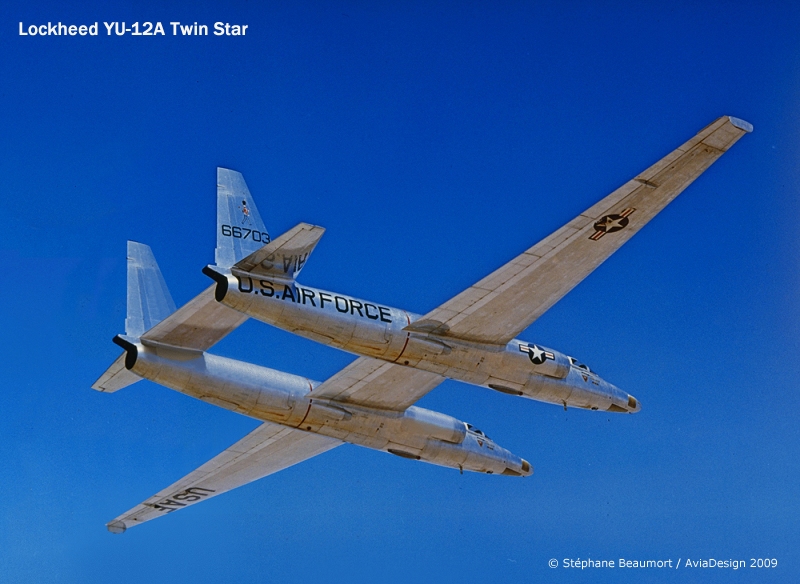
The Lockheed
YU-12A Twin Star prototype was proposed by Lockheed to the US Air Force as a way to augment the range and autonomy of the original U-2 spyplane. Apparently this was not conclusive and the experiment was halted.
 Lockheed Model 98 Super Stardust
Lockheed Model 98 Super Stardust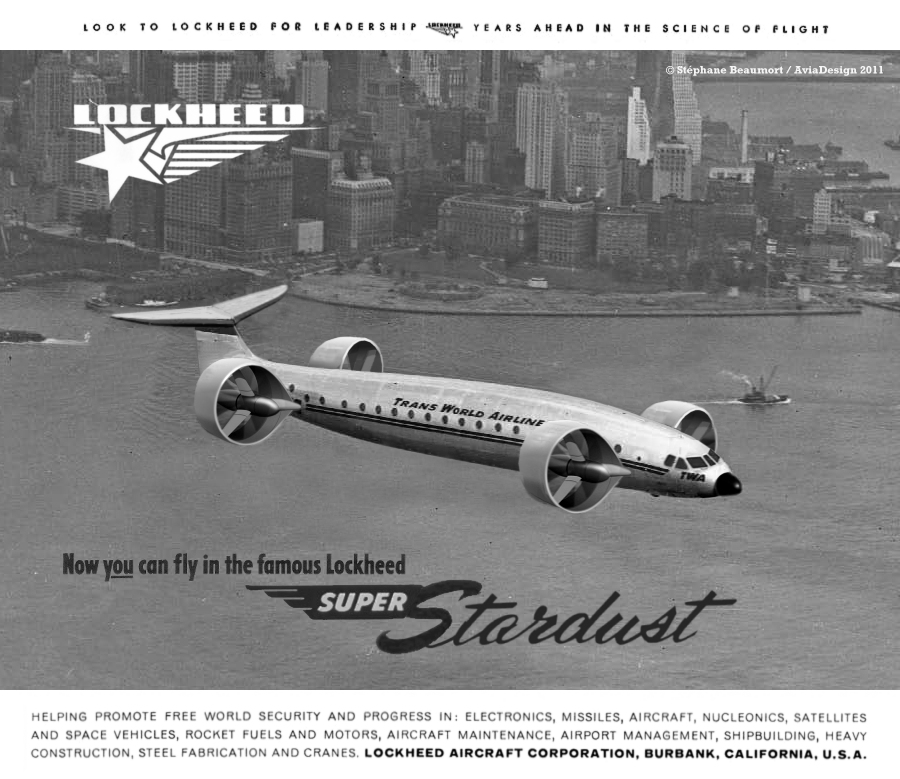
The Lockheed
Stardust and
Super Stardust were revolutionary VTOL passenger transports used by TWA in the mid-1960s and using technology developed for the Bell-Lockheed D-2064 assault transport project. These caused quite a commotion when they appeared and passengers mostly shied away from such revolutionary technology. Consequently, TWA reverted back to more traditional aircraft very soon.
 Lockheed CL-1860 Bright Star
Lockheed CL-1860 Bright Star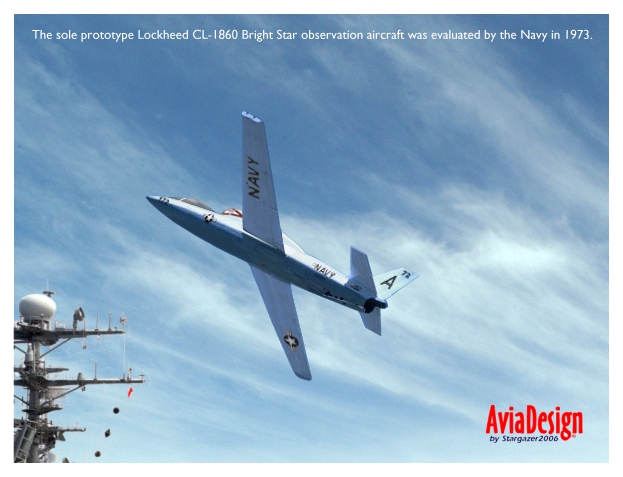
The Lockheed
CL-1860 Bright Star was an original attempt from Lockheed to produce a naval observation type at a reduced cost using elements of the U-2 spy plane. Though the length of the airframe was unchanged, the fin, rudders and wings were shortened (the latter being hinged for carrier use). 45% of the aircraft were taken directly from the U-2 production lines, and another 25% were modified from U-2 elements, leaving only 30% new, basically the cockpit and dorsal intake. The Navy evaluated the sole prototype in 1973 but tests were not conclusive enough to justify procurement.
 Lockheed Raven, a.k.a. "Baby Blackbird"
Lockheed Raven, a.k.a. "Baby Blackbird"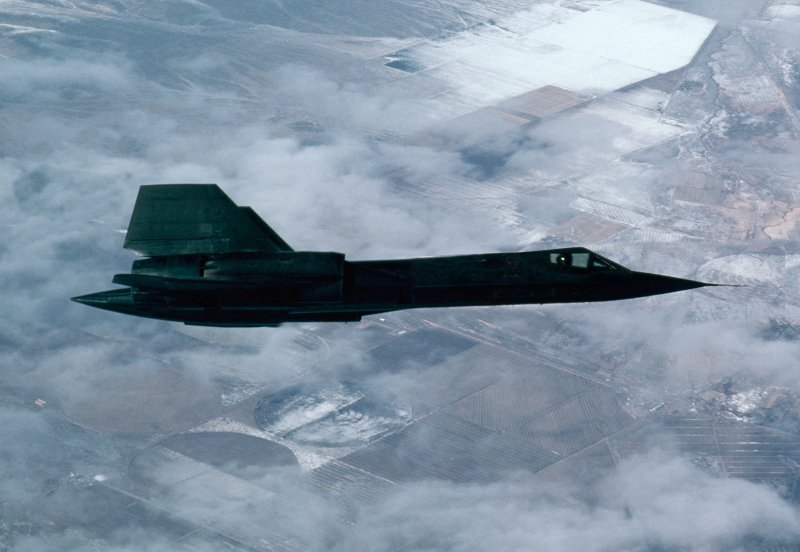
Ever wondered how the CIA and USAF could have accepted the most advanced aircraft in the world without even a single demonstrator first to validate the technologies? Well, the answer is easy: there actually WAS one. The Lockheed
Raven (affectionately known at the Skunk Works as the
"Baby Blackbird") was a sub-scale proof-of-concept demonstrator for the Oxcart/Cygnus programs, which spawned the famed
Blackbird family of aircraft. It was first flown on August 23, 1961.
 Lockheed A-24 Grumbler
Lockheed A-24 Grumbler
The Lockheed
A-24 Grumbler (inhouse designation) was an unrequested proposal for a fast, high-flying interceptor which built largely on SR-71 Blackbird technology, using the same engine, fuel and other components. Its original feature was to have a circular air intake all around the rear of the cockpit, not unlike the French
Coleoptère VTOL prototype of the 1950s. The sole
Grumbler prototype was never acquired by the US Air Force and therefore retained its civilian registration. It is seen here in formation with the classic Lockheed TR-1 (U-2RT)
Dragon Lady spyplane.
 Lockheed SR-72A Blackbolt
Lockheed SR-72A Blackbolt
The Lockheed
SR-72A Blackbolt was a triangular shaped variation on the famous SR-71A
Blackbird stratospheric spyplane. As most information pertaining to the program is still classified, it is not known how many were procured and whether the type is still in active service.
 Lockheed C-30A Super Galaxy
Lockheed C-30A Super Galaxy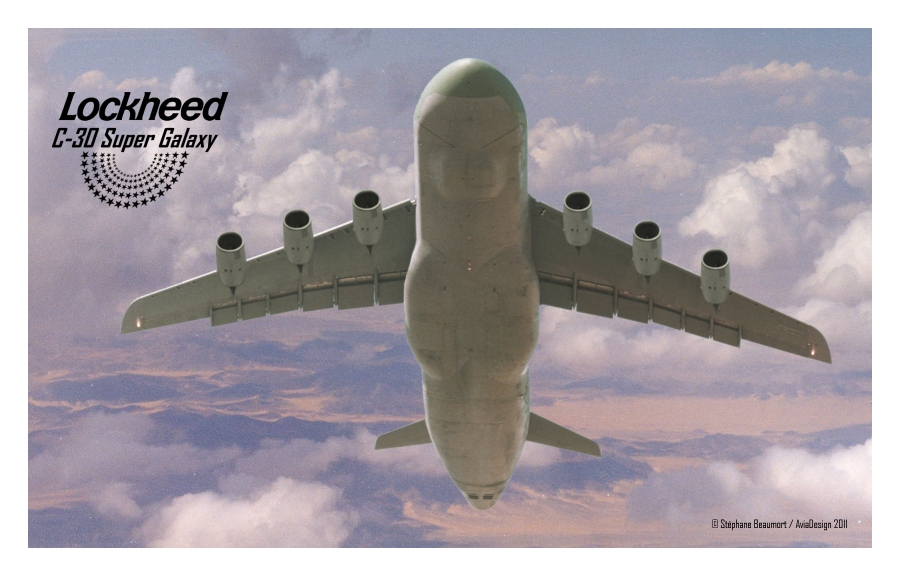
The Lockheed
C-30A Super Galaxy, a six-engined Lockheed
Galaxy with widened fuselage, came in very handy in Yugoslavia and Somalia to deliver relief aid or material (12 armed tanks or two fully assembled fighter aircraft could be carried), but also for mass paratrooper droppings (no less than 200 soldiers could jump in one single flight).
 Lockheed YSR-5A 'Senior Pike'
Lockheed YSR-5A 'Senior Pike'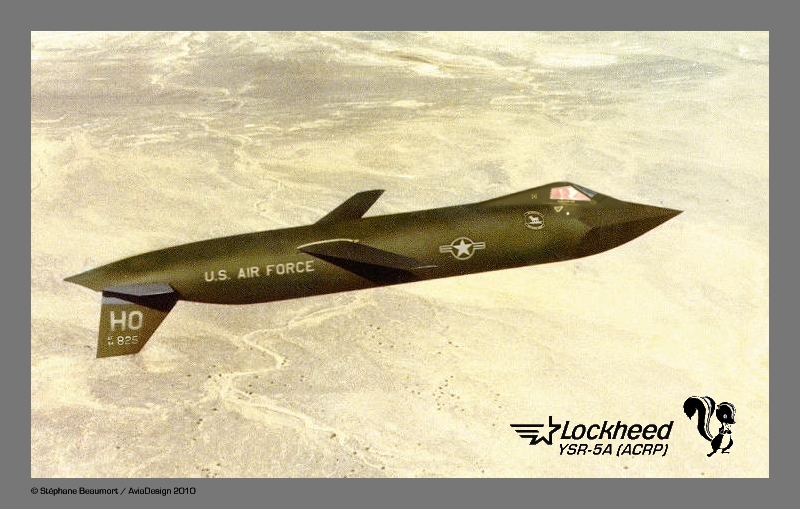
Developed under the 'Senior Pike' program, the
SR-5A answered a DoD specification for an
Advanced Cruise Rocket Plane (ACRP). It consisted of a scaled-up Raytheon (General Dynamics) AGM-129 Advanced Cruise Missile (ACM), a program that everyone thought had been axed while it actually served as a subscale prototype to this larger rocket plane. The SR-5A has flown in greatest secrecy since 1996, launched from NASA's famous NB-52 mothership, and this is the first time ever that a photo of it is published. No-one knows if the program is still running or if it was abandoned.
 Lockheed Martin YA-25A StarViper
Lockheed Martin YA-25A StarViper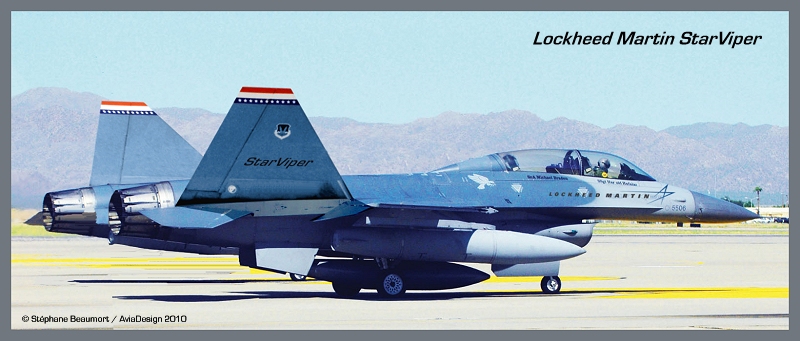
The
Lockheed StarViper demonstrator was the missing link between the famed F-16 and the F-22
Raptor. It was never procured in quantity and only 22 were built. All but two ended up with the Taiwanese Air Force.
 Lockheed X-55 Rising Star
Lockheed X-55 Rising Star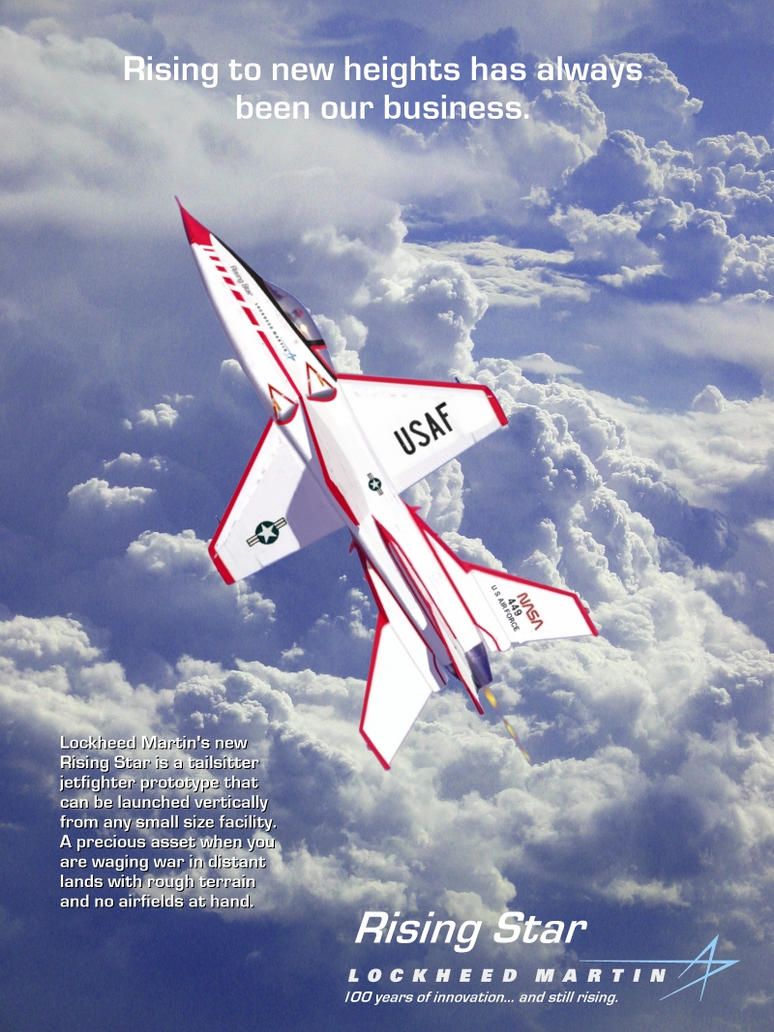
A technology demonstrator for a possible VATOL fighter.
 Lockheed Martin QF-35D UCAV
Lockheed Martin QF-35D UCAV
The Lockheed Martin
QF-35D UCAV is an unmanned variant of the new multiservice F-35
Lightning II combat platform.
 Lockheed Martin A-40A Thunderstar
Lockheed Martin A-40A Thunderstar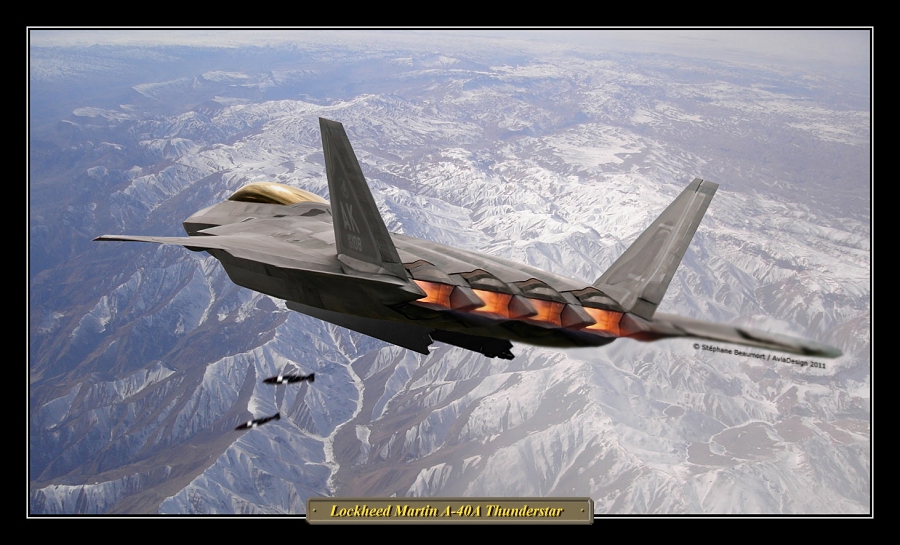
In 2017 the budget cuts that plagued many a defense program are no longer in order. The war in Afghanistan has been long and costly. The U.S. Department of Defense badly needs some high-flying light bombers to strike repeatedly the mountains hideouts of Afghanistan as a means to end war as quickly as possible. A requirement for a brand new, dedicated attack aircraft is issued, to which Lockheed Martin answers with the Thunderstar, a four-jet, enlarged derivative of the Raptor with side-by-side seating. The company wins the contract over Northrop Grumman and Boeing/Bombardier, and the
Thunderstar becomes the
A-40A. Eightly aircraft are purchased by USAF, and nearly 200 get exported to Britain and Germany. A naval variant, the A-40B, is also produced in 50 examples for the U.S. Navy, while 40 more examples find their way to Britain.
 Lockheed Martin YF-45A Starbolt
Lockheed Martin YF-45A Starbolt
Lockheed Martin answered a tender to procure a VLF (Very Light Fighter) by the year 2025 by reusing some of the F-35 experience and engineering. Thus was born the Lockheed Martin YF-45A
Starbolt, which will begin production in 2019... that is, unless some clever Congressmen decide to give it the axe...